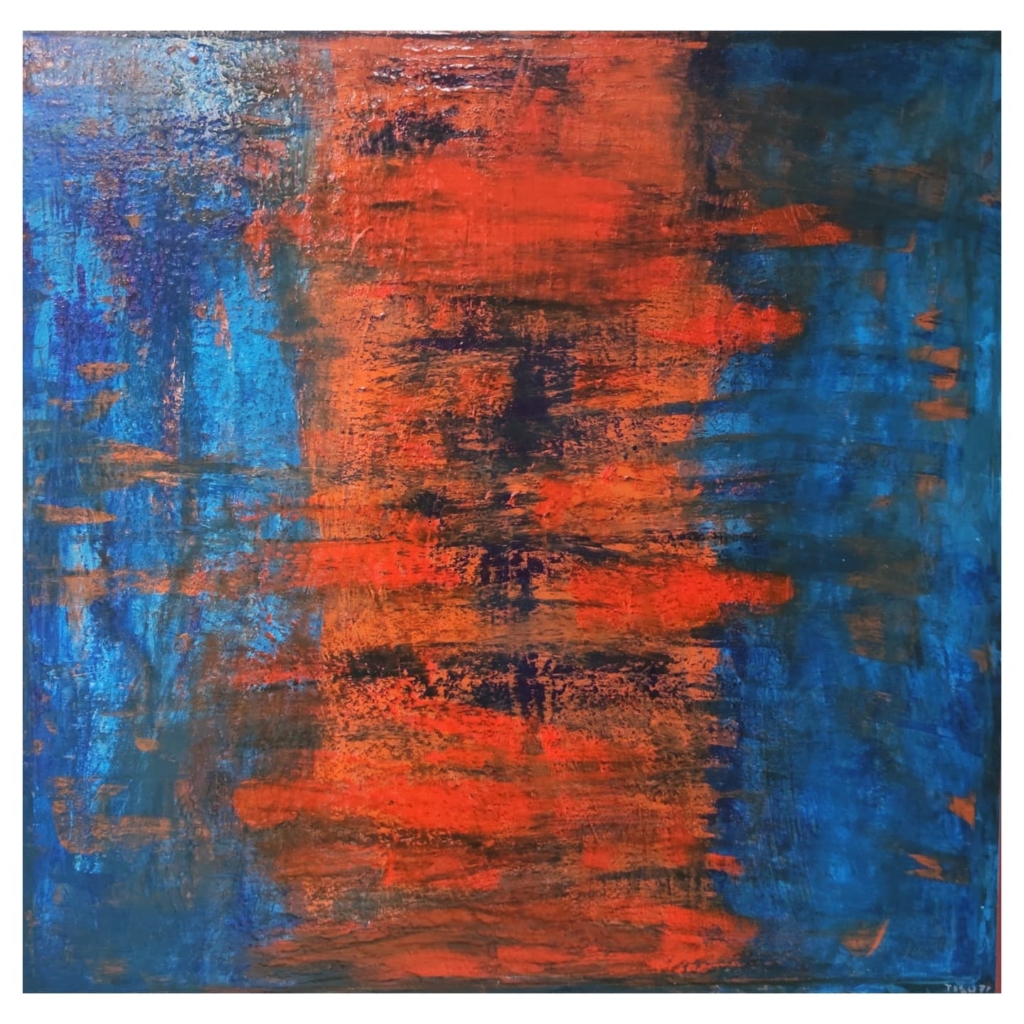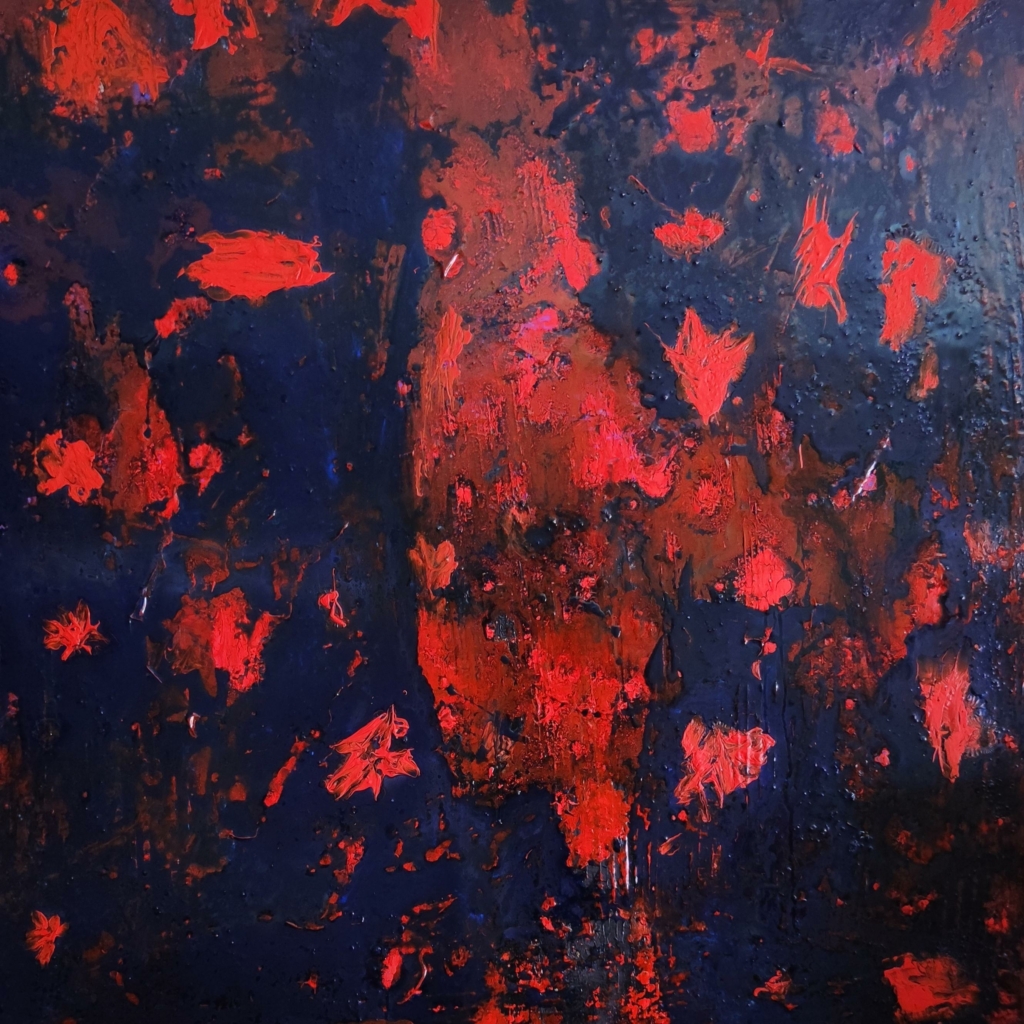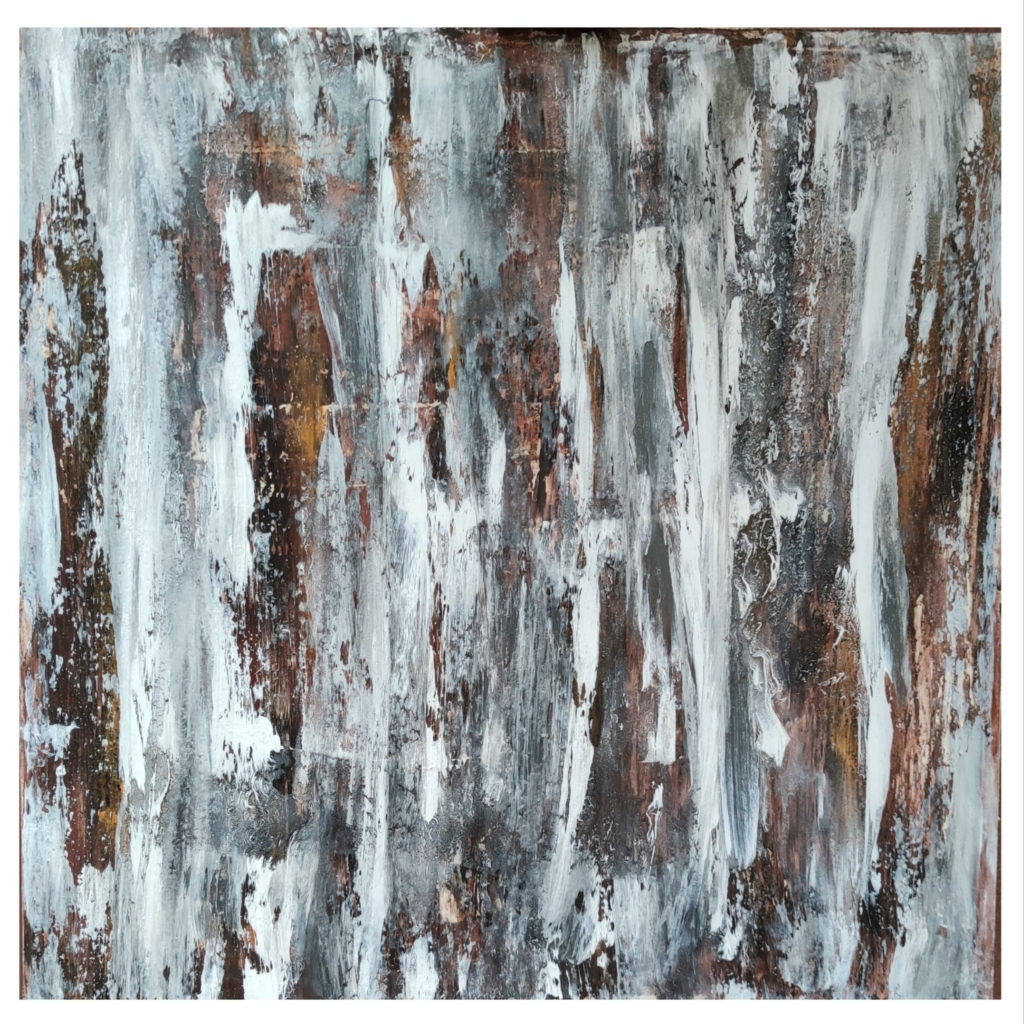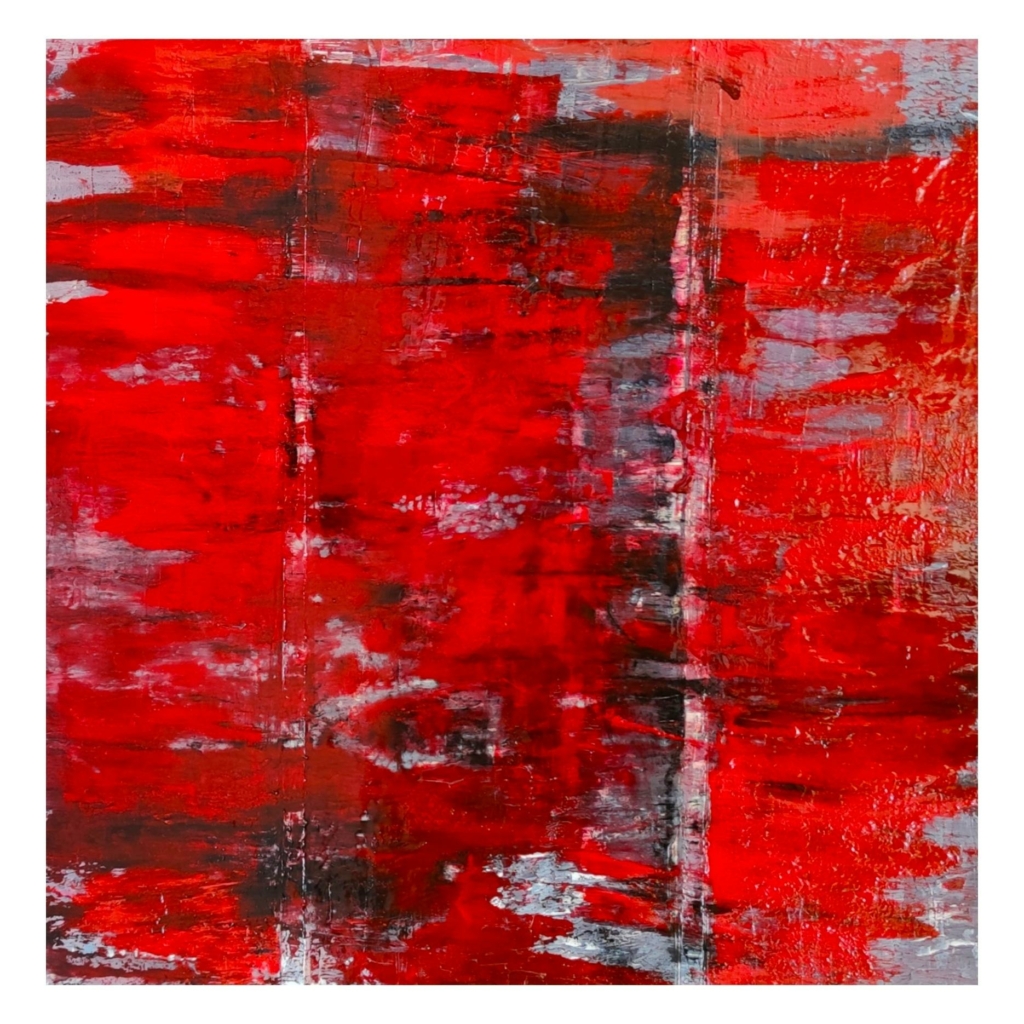di Marta Lock

Di origini rumene ma ormai da moltissimi anni residente a Mestre, un passo dalla splendida Venezia, Beatrice Mihaela Roman, in arte Tisu, lascia che l’arte entri nella sua vita lentamente, esattamente come le calme acque lagunari; il suo estro creativo fa capolino fin da bambina tuttavia nel percorso di crescita viene dimenticato, o forse sarebbe meglio dire accantonato perché lo stimolo verso la manifestazione artistica riappare nella sua vita tanto casualmente quanto insistentemente. Dovendo arredare la sua casa non riesce a trovare niente che fosse affine alla sua emotività così, su suggerimento di un amico, decide di mettersi al lavoro per creare qualcosa per se stessa, qualcosa in cui riconoscersi e ritrovarsi; da quel momento in poi non ha più smesso di sperimentare passando dalla tecnica mista con il collage, inserendo all’interno delle opere anche materiali solidi, plastici, che connettono la tela con lo spazio esterno, all’Espressionismo Astratto attraverso il quale comunicare in maniera spontanea e completa sensazioni confuse e impetuose, in cui non si limita a utilizzare l’acrilico bensì sceglie di mescolarlo con la resina dando al risultato finale un aspetto al tempo stesso più cangiante ma anche più viscoso. Dipingere per lei non è solo un modo per far ascoltare il proprio messaggio personale, la propria voce interiore, che riesce ad arrivare diretto al pubblico e ai collezionisti, molti, delle sue tele, bensì rappresenta anche un percorso di introspezione, di autoanalisi di tutte quelle emozioni trattenute all’interno di sé e che solo in virtù dell’esternazione pittorica riesce a comprendere e a portare alla luce della consapevolezza, superandole. Perché in fondo l’Espressionismo Astratto è proprio questo, la libertà di lasciar fuoriuscire ciò che non può essere trattenuto attraverso un linguaggio privo di schemi, privo di regole e di gabbie che renderebbero il percorso di liberazione meno immediato, meno spontaneo; e Beatrice Mihaela Roman sente l’esigenza di continuare a narrare liberamente se stessa o le sensazioni che riceve dal mondo circostante nella modalità più affine alla sua interiorità, quel misto di sensibilità e di determinazione nel non lasciarsi sopraffare dalle ansie della contingenza, di quella situazione attuale che tanto ha modificato l’esistenza quotidiana di tutto il mondo e che ha costante bisogno di essere metabolizzata, superata, esorcizzata. La tela The Second Chakras (Il secondo Chakra)

esprime esattamente questa necessaria connessione con le pulsioni più profonde, più intime, che sono conservate nello chakra sacrale in cui è fondamentale la congiunzione con l’esterno alla propria interiorità; i colori attribuiti dalla Roman a quest’opera sono quelli che contraddistinguono l’elemento legato allo chakra sacrale, cioè l’acqua, e il colore con cui è rappresentato, l’arancione. Ecco dunque che nella tela le due tonalità si incontrano e si completano dando vita a un’opera in cui la sinergia riesce a superare i contrasti, quello dei toni freddi e di quelli caldi, metafora della passionalità interna all’individuo e dell’apparente distanza con tutto ciò che è al di fuori e che solo con uno sforzo di mediazione può essere superata. In Faithful Dream (Sogno di fede)

l’artista sembra porre l’accento sull’apparente immobilità della contingenza che toglie spazio alla fiducia, all’immaginazione e ai sogni, spazio che proprio in virtù della sua natura emotiva e romantica auspica divenga chiave di lettura, e di svolta, la capacità di intravedere la luce oltre il buio, i coriandoli di gioia all’interno di un’esistenza a volte monotona, come indicato dalla base scura della tela che però può anche essere vista come lo sfondo in virtù del quale quegli attimi più vivaci saranno riconosciuti e apprezzati per il loro valore più alto e intenso.Andiamo ora a scoprire altri risvolti dell’artista, direttamente dalla sua voce.
Beatrice, il suo percorso artistico da adulta è cominciato da un’esigenza personale, quella di arredare la sua casa, ci racconta come è riuscita a trasformare questa necessità nella sua attuale vita professionale? Quali sono stati i passaggi che l’hanno condotta a trovare un suo personale stile?
Ho riscoperto me stessa, le cose che amavo di più da piccola la passione per il creare e lo stupirmi per i risultati ottenuti quando termino un’opera. Credo fortemente che niente avvenga per caso, tutto ha un suo percorso tracciato che si comprende solo a posteriori. Non ho avuto la possibilità di seguire un corso di studi che valorizzasse la mia indole creativa ma poi nel 2003 ho sentito che era arrivato il momento di dedicarmi a me stessa; da quel momento gli eventi, i passaggi sono giunti in modo naturale. Ho cominciato con il collage in cui utilizzavo materiali di recupero perché non mi è mai piaciuta l’idea di sprecare le cose, gli oggetti e così ho voluto dare una seconda vita, un nuovo senso a ciò che diversamente sarebbe stato semplicemente gettato via. Il passaggio verso altre tecniche è arrivato spontaneamente in mancanza del materiale per collage ma la mia voglia di creare ed esteriorizzare le mie emozioni era troppo forte così mi sono adattata a quello che trovavo in commercio nel periodo delle restrizioni durante la pandemia. Mi sono trovata ad avere tanto tempo libero e tanta fantasia. La vita professionale come artista è nata dalle prime mostre importanti, Biennale di Milano, Roma, Miami, che hanno avuto un impatto molto positivo e sono state per me l’incentivo a continuare su questa strada.

Ci sono stati dei maestri del passato a cui si è ispirata o che sente più affini alle sue corde espressive?
Non avendo potuto seguire un indirizzo di studi specifico né corsi formativi di pittura, conosco i più importanti maestri del passato per una mia cultura personale; non posso dire di seguire o inspirarmi a qualcuno di specifico nel mio stile artistico piuttosto amo pensare che siano gli esperti, con il loro sguardo critico, a collocarmi e inserirmi all’interno di stili e generi pittorici trovando somiglianze e affinità. Ogni volta che mi appresto a iniziare un’opera lascio che la mano entri liberamente in connessione con l’impulso del momento. Stendo su la tela l’emozione che vivo in quel frangente, sia essa positiva o negativa. Mi sento affine con tutti quegli artisti che si mostrano, che raccontano la propria interiorità, attraverso le opere, lasciando fluire le emozioni sulla base di un vissuto, di un moto emozionale che non può essere trattenuto.
Quanto è importante mantenere il contatto con l’interiorità, con la spiritualità, in un’epoca in cui sembra essere molto più semplice fermarsi alla superficie dell’apparenza? E quanto invece è importante per lei interpretare le sue profondità attraverso la creazione artistica? Il mondo esterno può influire solo attraverso eventi che non dipendono da me ma non nel mio percorso di vita personale, quello più interiore poiché ho sempre preferito la solitudine piuttosto che adeguarmi a un mondo superficiale. Mi dispiaccio quanto mi scontro con circostanze che non posso controllare o che lasciano emergere la superficialità a discapito della sostanza così cerco di non farmi coinvolgere emotivamente. Esprimere i miei moti interiori è la cosa più importante. Non riuscirei a creare opere che non abbiano una parte di me, della mia intensità emotiva, delle mie fantasie, dei miei ricordi, desideri; credo che ciascuno di noi racchiuda in sé una grande fonte di energia e di ispirazione. Ogni artista esprime ed esteriorizza il suo essere interiore in un modo unico, e questo avviene non solo per l’arte figurativa bensì anche per chi fa musica, film, teatro.
Sono una persona che riesce a comunicare meglio attraverso le opere piuttosto che con le parole. Essendo abbastanza diretta nel linguaggio verbale che può essere un po’ disarmante per gli altri, attraverso l’arte riesco invece a mantenere e far fuoriuscire la mia femminilità esprimendo con sensibilità i sentimenti, le emozioni e lascio sempre una porta aperta a chi vuol vedere oltre.

Gli ultimi due anni sono stati particolarmente complessi per l’intera popolazione mondiale, quali trasformazioni hanno generato in lei e nel suo linguaggio pittorico?
Nel periodo buio della pandemia ho scoperto il mio essere Donna Artista, ho appreso ad apprezzare di più tutte le cose che ho, curo di più i miei affetti personali, mi sto impegnando a cercare risposte sul senso della vita e credo che il periodo della pandemia abbia stimolato gran parte dell’umanità a porsi le stesse domande, a rivalutare i valori più importanti. Tutto il tempo libero che ci ha costretti a rimanere con noi stessi ha portato molti di noi a revisionare il percorso di vita seguito fino a quel momento e a rivedere le priorità sulla base di quello che ci rende più sereni. Le risposte non sono sempre chiare però trovo la pace interiore quando guardo il risultato di ogni opera finita.
Quando dipingo ascolto sempre della buona musica che diventa protagonista dell’opera in corso, la musica rispecchia e riflette il mio stato d’animo e l’emotività del momento creativo trasformando l’atto del dipinge in un viaggio introspettivo che cura il complesso vivere nell’attuale situazione globale.

Lei ha venduto moltissime opere nel corso della sua carriera, e ha partecipato a mostre collettive in Italia e all’estero, quali sono i suoi prossimi progetti? Sto lavorando per la pubblicazione delle mie opere su tre cataloghi molto importanti: il Catalogo Nebule 2022 con galleria SV Venezia di cui sono socia, dove saranno presenti artisti accuratamente selezionati con le loro opere; il Catalogo GAA Global Art Agency, di importanza internazionale che uscirà nel 2022 A Londra; e il Catalogo Dell’Arte Moderna Nr 58 CAM Mondadori che uscirà nel novembre 2022. Sarò presente nella Fiera di Padova nel novembre 2021 e all’importantissima Fiera Art Expo New York in calendario per il mese di aprile 2022 con tre opere selezionate dagli esperti del Redwood Art Group (USA). A novembre 2021 sarò tra gli artisti dell’esposizione collettiva presso il Venezia Galleria SV in campo San Zaccaria. Sono sempre più attenta quando decido di partecipare alle mostre d’arte e inserimento nei cataloghi poiché sto effettuando un percorso di maturazione come persona e come artista. Il mio sogno nel cassetto, avendo sempre avuto un amore per i animali, gatti in particolare, è di riuscire più avanti a creare o aderire a una fondazione che si occupa della causa. Mi renderebbe molto felice e anche compiuta sia spiritualmente che emotivamente riuscire a creare un connubio tra arte e l’aiuto agli animali randagi. Vivere solo d’Arte non è facile ma neanche impossibile.
BEATRICE ROMAN-CONTATTI
Email: info@beatriceroman.it
Sito web: www.beatriceroman.it
Facebook: https://www.facebook.com/roman.b.mihaela/
Instagram: https://www.instagram.com/beatrice_roman_tisu_art/
Marta Lock’s interviews:
Beatrice Mihaela Roman, the irresistible path of creativity
Of Romanian origin but now living for many years in Mestre, a stone’s throw from the beautiful Venice, Beatrice Mihaela Roman, aka Tisu, lets art enter her life slowly, just like the calm waters of the lagoon; her creative flair has been peeping out since she was a child, but in the course of her growth it was forgotten, or perhaps it would be better to say set aside, because the stimulus towards artistic expression reappears in her life as casually as it does insistently. When she had to furnish her house, she could not find anything that was close to her emotions, so, on the suggestion of a friend, she decided to set to work to create something for herself, something in which she could recognise and find herself; from that moment she has never stopped experimenting, going from mixed media with collage, including in her artworks solid, plastic materials that connect the canvas with external space, to Abstract Expressionism, through which she spontaneously and completely communicates confused and impetuous sensations, in which she does not limit herself to using acrylic but chooses to mix it with resin, giving the final result a more iridescent but also more viscous appearance. For her, painting is not only a way to make her personal message heard, her inner voice, which manages to reach the public and the many collectors of her canvases directly, but it also represents a path of introspection, of self-analysis of all those emotions held within herself and which only by virtue of pictorial externalization can she understand and bring to the light of awareness, overcoming them. Because after all, this is what Abstract Expressionism is all about, the freedom to let out what cannot be held back through a language devoid of schemes, devoid of rules and cages that would make the path to liberation less immediate, less spontaneous; and Beatrice Mihaela Roman feels the need to continue to freely narrate herself or the sensations she receives from the world around her in the manner most akin to her inner self, that mixture of sensitivity and determination not to be overwhelmed by the anxieties of contingency, of the current situation that has changed so much the daily existence of the whole
world and that constantly needs to be metabolised, overcome, exorcised. The canvas The Second Chakras expresses exactly this necessary connection with the deepest, most intimate impulses, which are preserved in the sacral chakra, where the conjunction with the outside world and one’s own interiority is fundamental. The colours attributed by Roman to this artwork are those that distinguish the element linked to the sacral chakra, namely water, and the colour with which it is represented, orange. The two tones meet and complement each other in the canvas, creating a work in which the synergy manages to overcome the contrasts of cold and warm tones, a metaphor for the individual’s inner passion and apparent distance from everything outside, which can only be overcome through mediation. In Faithful Dream, the artist seems to emphasise the apparent immobility of contingency, which takes away space for trust, imagination and dreams, a space which, precisely because of its emotional and romantic nature, she hopes will become a key to interpretation, and a turning point, the ability to glimpse the light beyond the darkness, the confetti of joy within a sometimes monotonous existence, as indicated by the dark base of the canvas, which, however, can also be seen as the background against which those livelier moments will be recognised and appreciated for their higher and more intense value.
Let us now discover other aspects of the artist, directly from her voice.
Beatrice, your artistic journey as an adult began with a personal need, that of furnishing your home. Can you tell us how you managed to transform this need into your current professional life? What were the steps that led you to find your own personal style?
I rediscovered myself, the things I loved most as a child, the passion for creating and being amazed at the results when I finish a work. I strongly believe that nothing happens by chance, everything has its own path that can only be understood afterwards. I did not have the opportunity to follow a course of study that would enhance my creative nature, but then in 2003 I felt that the time had come to dedicate myself to myself; from that moment on, the events, the steps came naturally. I started with collage using recycled materials because I
have never liked the idea of wasting things, objects and so I wanted to give a second life, a new meaning to what otherwise would have simply been thrown away. The transition to other techniques came spontaneously in the absence of collage material, but my desire to create and externalize my emotions was too strong, so I adapted to what I found on the market during the period of restrictions in the pandemic. I found myself with a lot of free time and imagination. My professional life as an artist started with my first major exhibitions, Biennale in Milan, Rome, Miami, which had a very positive impact and were the incentive for me to continue on this path.
Are there any masters from the past who have inspired you or who you feel are closest to your expressive chords?
Since I have not been able to follow a specific course of study or training in painting, I know the most important masters of the past for my own personal culture; I cannot say that I follow or am inspired by someone specific in my artistic style, but rather I like to think that it is the experts, with their critical eye, who place and set me within pictorial styles and genres, finding similarities and affinities. Whenever I am about to start a work, I let my hand connect freely with the impulse of the moment. I put on the canvas the emotion I feel at that moment, whether positive or negative. I feel akin to all those artists who show themselves, who recount their inner selves through their artworks, letting their emotions flow on the basis of an experience, of an emotional motion that cannot be held back.
How important is it to maintain contact with the inner self, with spirituality, in an era in which it seems much easier to stop at the surface of appearances? And how important is it for you to interpret your depths through artistic creation?
The outside world can only influence me through events that do not depend on me, but not in my personal life path, the inner one, as I have always preferred solitude rather than adapting to a superficial world. I regret when I come up against circumstances that I cannot control or that let superficiality emerge at the expense of substance so I try not to get emotionally involved. Expressing my inner feelings is the most important thing.
I couldn’t create artworks that don’t have a part of me, of my emotional intensity, my fantasies, my memories, my desires; I believe that each of us contains a great source of energy and inspiration. Every artist expresses and externalises his inner being in a unique way, and this is true not only for the visual arts but also for those who make music, films and theatre.
I am a person who can communicate better through artworks than through words. As I am quite straightforward in my verbal language, which can be a bit disarming for others, through art I am able to maintain and bring out my femininity by expressing feelings and emotions with sensitivity, and I always leave a door open to those who want to see beyond it.
The last two years have been particularly complex for the entire world population, what transformations have they generated in you and in your pictorial language?
During the dark period of the pandemic, I discovered that I am a woman artist, I learned to appreciate more all the things I have, I am caring more for my personal affections, I am striving to find answers about the meaning of life and I believe that the period of the pandemic has stimulated most of humanity to ask themselves the same questions, to re-evaluate the most important values. All the free time that has forced us to stay with ourselves has led many of us to review the path of life followed up to that moment and to review our priorities on the basis of what makes us more serene. The answers are not always clear, but I find inner peace when I look at the result of each finished work.
When I paint, I always listen to good music which becomes the protagonist of the work in progress, the music reflects my state of mind and the emotionality of the creative moment, transforming the act of painting into an introspective journey that cures the complex living in the current global situation.
You have sold many artworks during your career, and participated in group exhibitions in Italy and abroad, what are your next projects?
I am working on the publication of my works in three very important catalogues: the Nebule Catalogue 2022 with SV Venezia gallery of which I am a member, where carefully selected artists will be present with their
works; the GAA Global Art Agency Catalogue of international importance which will be published in London in 2022; and the Catalogo Dell’Arte Moderna Nr 58 CAM Mondadori which will be published in November 2022. I will be present at the Padua Fair in November 2021 and at the very important Art Expo New York Fair scheduled for April 2022 with three works selected by the experts of the Redwood Art Group (USA). In November 2021 I will be among the artists in the group exhibition at the Venezia Galleria SV in campo San Zaccaria. I am always more careful when I decide to take part in art exhibitions and insert myself in catalogues because I am on a path of maturation as a person and as an artist. My dream in the drawer, having always had a love for animals, cats in particular, is to be able to create or join a foundation that deals with this cause. It would make me very happy and also spiritually and emotionally fulfilled to be able to create a union between art and helping stray animals. Living by art alone is not easy, but it is not impossible either.
